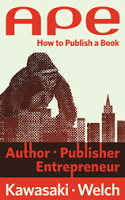Understanding Book Distribution (Part 1: Digital)
Channels of Distribution
This chapter provides an overview of the four main digital and print distribution channels. They are online ebook resellers (digital), direct sales (digital), author-services companies (digital and print), and print-on-demand (print). The chapters after this overview explain each channel in detail.

The self-publishing ecosystem is idiosyncratic, illogical, and fragmented. Apple, Amazon, Google, Adobe, Microsoft, and other self-publishing vendors try to optimize products and processes for themselves—creating a cross between a junkyard and a swap meet for authors.
The following decision matrix will help you clarify your options. It begins with two fundamental questions:
What kind of book do you want to publish?
Do you need help getting professional editing, cover design, layout design, and production?
The answers to these questions will help you decide on which channels of distribution to use.
Amanda Hocking is the heroine of self-publishing. She spent years pitching her vampire-romance novels to traditional publishers with no success. In April 2010 she learned that an exhibition about Jim Henson, the creator of the Muppets, was coming to Chicago. But Amanda, a Muppets fan, had no money to make the trip.
Undaunted, Hocking decided to self-publish her novels with Kindle Direct Publishing to pay for the $300 trip. She started with My Blood Approves , and by October 2010, she made over $20,000. Over the next twenty months, she made $2.5 million. The rest, as the saying goes, is history.
Hocking is not the norm for self-published authors. Many stories about self-publishing cite her because her experience is unusual, not typical. Still, people need heroes for inspiration and for proof that success is possible. Not every entrepreneur is going to start the next Apple, either, but it’s great to know that two guys in a garage started the most valuable company in the world.
Amazon (Kindle Direct Publishing), Apple (iBookstore), Barnes & Noble (Nook), Google (Google Play), and Kobo are the major online ebook resellers. For most self-published authors, they represent the easiest and most lucrative way to sell books. You may never need any distribution channel other than online ebook resellers.
Pros:
Inexpensive. All you need to self-publish an ebook is a computer, word processor, and Internet access. If you start distribution through other channels, you may need more professional tools, but you can worry about this later.
Easy. Fiction writers can click on an “Upload” button, find their Word file, transmit it, wait for the reseller to process the file, and start selling in a few days. This isn’t true for complicated nonfiction books because of file-conversion issues, but it is possible for most fiction authors.
Quick. You can convert your book from manuscript to market in less than a week. The best case, Kindle Direct Publishing, prides itself on a forty-eight-hour turnaround. Amazon and Apple also enable you to launch your non-translated book in dozens of countries at the same time.
Lucrative. You can make up to 70 percent of the selling price of an ebook from online resellers. Making $2 on a $3 book is a sweet deal if you can achieve a large volume.
Cons:
Limited reach. You will miss people who prefer printed books. This is especially true for nonfiction books. For example, many engineers still prefer buying a printed book for technical topics such as iOS development, and many photography fans would rather own a printed book than an ebook.
Less “real.” We’re not Luddites or book snobs, but we still think that hefting, smelling, and autographing a printed book is special. Later we’ll explain ways to distribute both ebook and printed versions of your book, but if you only publish ebooks, you will miss this feeling.

Guy Kawasaki has written 12 books, 10 of which were traditionally published. His newest book is APE: Author, Publisher, Entrepreneur - How to Publish a Book, which helps people understand how and why to self-publish.
APE: Author, Publisher, Entrepreneur - How to Publish a Book, by Guy Kawasaki and Shawn Welch, is available as an eBook ($9.99) and in paperback ($24.99). Visit http://apethebook.com/








Published on November 10, 2013 19:33
No comments have been added yet.



